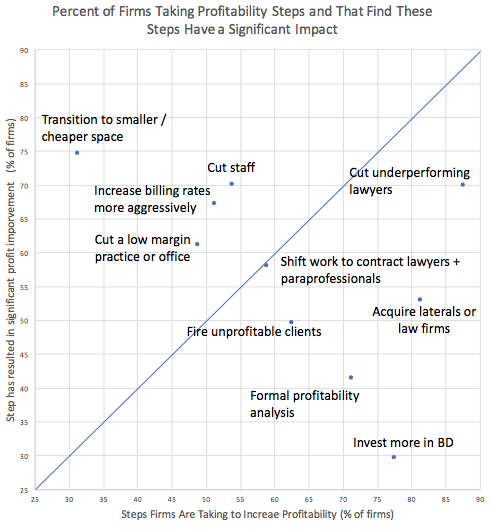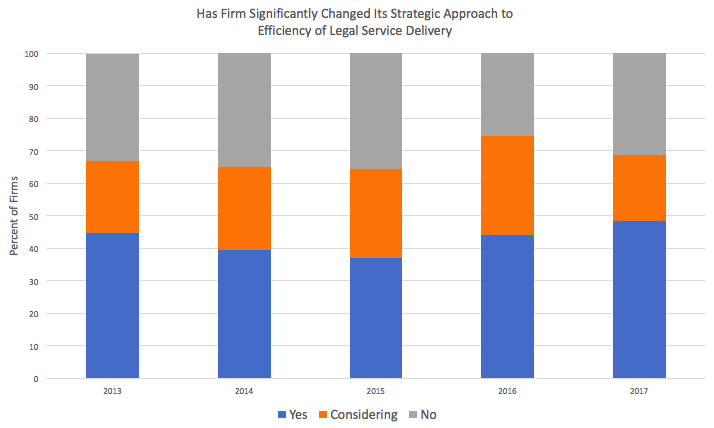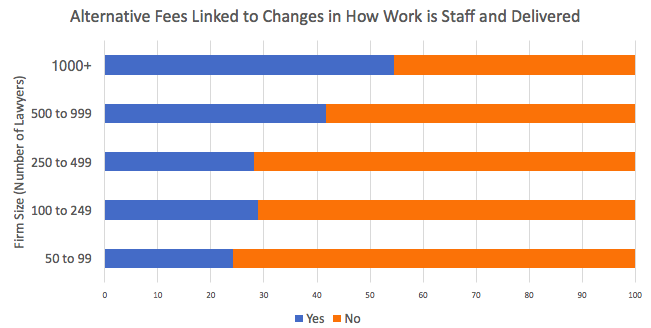In today’s post, Law Firm Profitability + Service Delivery Ron Friedmann analyses data from the recent Altman Weil Survey in the US to show just how internally-focused BigLaw firms can be. Ron’s message is telling: The raison d’être for any professional services firm is service to clients. Its profitability is a function of the extent a firm does this successfully and sustainably.
Law firm management needs to think more about their clients. Right now, they expend more energy on boosting profitability with inward measures than they do on client service. That cannot be sustainable.
Below the diagonal means a higher percentage of firms take a step than find that step successful. For example, almost 80% of firms invest in more in business development but only 30% report it works. Points far below the diagonal suggest firms must stop the activity or re-think how they do it. Above means steps with a higher percentage of success than the percent of firms using them. I suspect real estate sits far away from the diagonal because leases are long term. (Many firms are shrinking space per lawyer when they do move.)
Only one step focuses on clients: shifting work to contract lawyers and paraprofessionals. That relates directly to client experience; it improves client value and enhance profits. All the other steps focus inward.
I suspect that Altman Weil’s answer choices reflect reality. Most firms think more about internal issues than clients. Yet I believe firms will thrive only by improving client service with better delivery and lower cost. Fortunately, LFiT does offer insight to what firms are doing on client service. It asks (page 55) “Many law firms feel pressure to change elements of their business model to stay competitive in the post-recession economy. Has your firm significantly changed its strategic approach to the efficiency of legal service delivery?” This chart shows the time trend of LFiT answers:
Less than one-half of firms are changing their strategic approach to service efficiency. And the percent has bounced around for five years. We get even closer to delivery cost with the LFiT question (page 65) “In your law firm, are discounted, capped or alternative fees routinely linked to changes in how the work is staffed and delivered?”
Clients use alternative fee arrangements to lower cost and gain cost predictability. But most law firms do no change how they staff and deliver work under AFAs. Without change, I suspect an AFA just move numbers around – or firms take margin hits.
By not investing in service delivery and changing how they work, firms miss their biggest profit lever. Under AFA, if firms change how they work to reduce cost, clients get better value and law firms higher profits. Reasons for limited change include a general resistance to change, a misalignment between how firms compensate partners and how they measure profitability, or not having the right professional staff to help with new initiatives.
I suppose this is a glass-half-empty situation. Some firms are taking steps. For example, consider artificial intelligence. LFiT has, for several years running, asked about AI. This year, it asked (page 84) “Technology tools that incorporate artificial intelligence (AI) and machine learning – like Watson and Ross – are beginning to be adopted by some law firms. What is your firm’s stance on the use of legal AI tools?” Here are the answers by firm size.
Perhaps in future surveys of clients, Chief Legal Officers will report that they are gaining value from AI.
The survey paints a bleaker picture than I expected. For a while, I thought perhaps I was missing something. But then I re-read the LFiT conclusion: “Some of this year’s results should be disturbing to every lawyer, but opportunities also abound. Law firms that seize those opportunities can create an important competitive advantage. We hope they will take up the challenge.”
So do I.







I’ll argue that the 77% of firms who claim to invest more in BD, but for whom it’s ineffective, are up against the intractable problem that the overwhelming percentage of lawyers don’t want to market or sell. Firms invest in hiring internal BD coaches and renting external ones. However, they have no way of identifying the small percentage of lawyers who want to succeed at BD. Their choices of who to train and coach are skewed to failure because of the unfounded belief that they know who has “BD potential.” Nobody knows that, and it’s impossible to discern prospectively. The only way to identify those who are serious and willing to commit the time and effort to justify meaningful investment is to make inexpensive starter tools available to everyone, and measure who does what — or doesn’t. For those who do, ramp things up gradually with additional, modest investments to enable them to demonstrate staying power. Once you’ve got behavioral evidence, invest heavily in those who’ve demonstrated the requisite commitment.